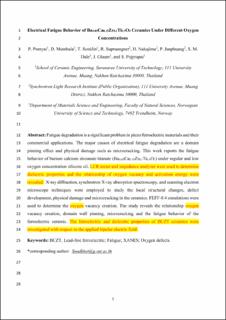| dc.contributor.author | Pomyai, P | |
| dc.contributor.author | Munthala, D | |
| dc.contributor.author | Sonklin, T | |
| dc.contributor.author | Supruangnet, R | |
| dc.contributor.author | Janphuang, P | |
| dc.contributor.author | Dale, Silje Marie | |
| dc.contributor.author | Glaum, Julia | |
| dc.contributor.author | Pojprapai, Soodkhet | |
| dc.date.accessioned | 2022-07-07T08:05:01Z | |
| dc.date.available | 2022-07-07T08:05:01Z | |
| dc.date.created | 2022-01-03T13:23:22Z | |
| dc.date.issued | 2021 | |
| dc.identifier.citation | Journal of the European Ceramic Society. 2021, 41 (4), 2497-2505. | en_US |
| dc.identifier.issn | 0955-2219 | |
| dc.identifier.uri | https://hdl.handle.net/11250/3003384 | |
| dc.description.abstract | Fatigue degradation is a significant problem in piezo/ferroelectric materials and their commercial applications. The major causes of electrical fatigue degradation are a domain pinning effect and physical damage such as microcracking. This work reports the fatigue behavior of barium calcium zirconate titanate (Ba0.85Ca0.15Zr0.1Ti0.9O3) under regular and low oxygen concentration silicone oil. Impedence analyzer and LCR meter are employed to analyzer the dielectric properties and it also revealed the relationship between activation energy and oxygen vacancy. X-ray diffraction, synchrotron X-ray absorption spectroscopy, and scanning electron microscope techniques were employed to study the local structural changes, defect development, physical damage and microcracking in the ceramics. FEFF-8.4 simulations were used to determine the oxygen vacancy creation. The study reveals the relationship of oxygen vacancy creation, domain wall pinning, microcracking and the fatigue behavior of the ferroelectric ceramic. The work investigated the dielectric and ferroelectric properties of BCZT ceramics intermes of applied electric field. | en_US |
| dc.language.iso | eng | en_US |
| dc.publisher | Elsevier | en_US |
| dc.rights | Attribution-NonCommercial-NoDerivatives 4.0 Internasjonal | * |
| dc.rights.uri | http://creativecommons.org/licenses/by-nc-nd/4.0/deed.no | * |
| dc.title | Electrical fatigue behavior of Ba0.85Ca0.15Zr0.1Ti0.9O3 ceramics under different oxygen concentrations | en_US |
| dc.type | Peer reviewed | en_US |
| dc.type | Journal article | en_US |
| dc.description.version | acceptedVersion | en_US |
| dc.rights.holder | This is the authors' accepted manuscript to an article published by Elsevier. | en_US |
| dc.source.pagenumber | 2497-2505 | en_US |
| dc.source.volume | 41 | en_US |
| dc.source.journal | Journal of the European Ceramic Society | en_US |
| dc.source.issue | 4 | en_US |
| dc.identifier.doi | 10.1016/j.jeurceramsoc.2020.12.016 | |
| dc.identifier.cristin | 1973724 | |
| cristin.ispublished | true | |
| cristin.fulltext | postprint | |
| cristin.qualitycode | 1 | |

